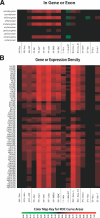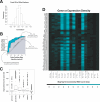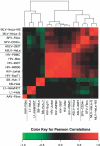Selection of target sites for mobile DNA integration in the human genome
- PMID: 17166054
- PMCID: PMC1664696
- DOI: 10.1371/journal.pcbi.0020157
Selection of target sites for mobile DNA integration in the human genome
Abstract
DNA sequences from retroviruses, retrotransposons, DNA transposons, and parvoviruses can all become integrated into the human genome. Accumulation of such sequences accounts for at least 40% of our genome today. These integrating elements are also of interest as gene-delivery vectors for human gene therapy. Here we present a comprehensive bioinformatic analysis of integration targeting by HIV, MLV, ASLV, SFV, L1, SB, and AAV. We used a mathematical method which allowed annotation of each base pair in the human genome for its likelihood of hosting an integration event by each type of element, taking advantage of more than 200 types of genomic annotation. This bioinformatic resource documents a wealth of new associations between genomic features and integration targeting. The study also revealed that the length of genomic intervals analyzed strongly affected the conclusions drawn--thus, answering the question "What genomic features affect integration?" requires carefully specifying the length scale of interest.
Conflict of interest statement
Figures






References
-
- Lander ES, Linton LM, Birren B, Nusbaum C, et al. Initial sequencing and analysis of the human genome. Nature. 2001;409:860–921. - PubMed
-
- Venter JC, Adams MD, Myers EW, Li PW, Mural RJ, et al. The sequence of the human genome. Science. 2001;291:1304–1351. - PubMed
-
- Craig NL, Craigie R, Gellert M, Lambowitz AM, editors. Mobile DNA II. Washington (D.C.): ASM Press; 2002. 1204
-
- Bushman FD. Lateral DNA transfer: Mechanisms and consequences. New York: Cold Spring Harbor Laboratory Press; 2001. 448
-
- Hacein-Bey-Abina S, von Kalle C, Schmidt M, Le Deist F, Wulffraat N, et al. A serious adverse event after successful gene therapy for X-linked severe combined immunodeficiency. N Engl J Med. 2003;348:255–256. - PubMed
Publication types
MeSH terms
Substances
Grants and funding
LinkOut - more resources
Full Text Sources
Other Literature Sources

